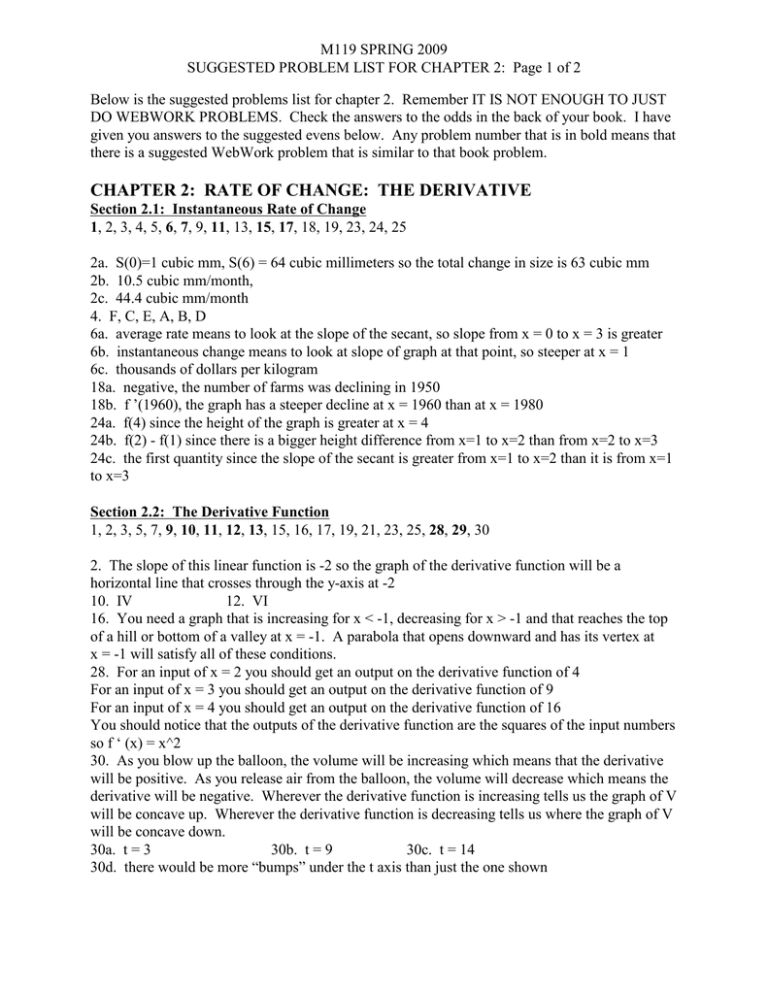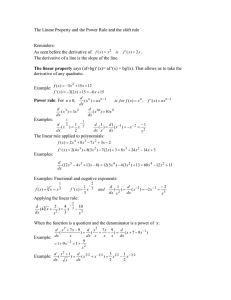chapter 2 - Oncourse
advertisement

M119 SPRING 2009 SUGGESTED PROBLEM LIST FOR CHAPTER 2: Page 1 of 2 Below is the suggested problems list for chapter 2. Remember IT IS NOT ENOUGH TO JUST DO WEBWORK PROBLEMS. Check the answers to the odds in the back of your book. I have given you answers to the suggested evens below. Any problem number that is in bold means that there is a suggested WebWork problem that is similar to that book problem. CHAPTER 2: RATE OF CHANGE: THE DERIVATIVE Section 2.1: Instantaneous Rate of Change 1, 2, 3, 4, 5, 6, 7, 9, 11, 13, 15, 17, 18, 19, 23, 24, 25 2a. S(0)=1 cubic mm, S(6) = 64 cubic millimeters so the total change in size is 63 cubic mm 2b. 10.5 cubic mm/month, 2c. 44.4 cubic mm/month 4. F, C, E, A, B, D 6a. average rate means to look at the slope of the secant, so slope from x = 0 to x = 3 is greater 6b. instantaneous change means to look at slope of graph at that point, so steeper at x = 1 6c. thousands of dollars per kilogram 18a. negative, the number of farms was declining in 1950 18b. f ’(1960), the graph has a steeper decline at x = 1960 than at x = 1980 24a. f(4) since the height of the graph is greater at x = 4 24b. f(2) - f(1) since there is a bigger height difference from x=1 to x=2 than from x=2 to x=3 24c. the first quantity since the slope of the secant is greater from x=1 to x=2 than it is from x=1 to x=3 Section 2.2: The Derivative Function 1, 2, 3, 5, 7, 9, 10, 11, 12, 13, 15, 16, 17, 19, 21, 23, 25, 28, 29, 30 2. The slope of this linear function is -2 so the graph of the derivative function will be a horizontal line that crosses through the y-axis at -2 10. IV 12. VI 16. You need a graph that is increasing for x < -1, decreasing for x > -1 and that reaches the top of a hill or bottom of a valley at x = -1. A parabola that opens downward and has its vertex at x = -1 will satisfy all of these conditions. 28. For an input of x = 2 you should get an output on the derivative function of 4 For an input of x = 3 you should get an output on the derivative function of 9 For an input of x = 4 you should get an output on the derivative function of 16 You should notice that the outputs of the derivative function are the squares of the input numbers so f ‘ (x) = x^2 30. As you blow up the balloon, the volume will be increasing which means that the derivative will be positive. As you release air from the balloon, the volume will decrease which means the derivative will be negative. Wherever the derivative function is increasing tells us the graph of V will be concave up. Wherever the derivative function is decreasing tells us where the graph of V will be concave down. 30a. t = 3 30b. t = 9 30c. t = 14 30d. there would be more “bumps” under the t axis than just the one shown M119 SPRING 2009 SUGGESTED PROBLEM LIST FOR CHAPTER 2: Page 2 of 2 Section 2.3: Interpretations of the Derivative 1, 3, 8, 9, 17, 19, 21, 23, 27 8a. When the price is $15 the quantity sold is 200 products 8b. When the price reaches $15, the quantity sold is DECREASING at a RATE of 25 products per dollar. (Which means once the price reaches $15, if we increase the price by $1 we will sell about 25 fewer products) Section 2.4: The Second Derivative 1, 3, 5, 7, 8, 9, 11, 13, 15, 17, 20, 21, 29 8. The first derviative is negative since the function is decreasing and the second derivative is positive since the function is decreasing at a decreasing rate (concave up). 20a. You are given the graph of f(x) so f(x) will be negative wherever f(x) is below the axis, so x4, x5 20b. You are given the graph of f(x) so f ‘(x) will be negative wherever f(x) is decreasing, so x3, x4 20c. You are given the graph of f(x) so f(x) will be decreasing wherever f(x) going down from left to right, so x3, x4 (same as part b) 20d. You are given the graph of f(x) so f ‘(x) will be decreasing wherever f(x) is concave down, so x2, x3 20e. You are given the graph of f(x) so f(x) will have a positive slope wherever the graph of f(x) in increasing, so x1, x2, x5 20f. You are given the graph of f(x) so the slope of f(x) will be increasing wherever the graph of f(x) in concave up, so x1, x4, x5 Section 2.5: Marginal Cost and Revenue 1, 2, 3, 5, 7, 9, 10, 11, 14 2. You cannot get a very accurate answer with this graph, but you should notice that the squares on the q axis are 150 units apart and the squares on the R axis are 2,500 dollars apart. Using the approximate points (450, 13000), (600, 16000), (750, 17500) you can compute a slope of a secant to the right of q = 600 and get $10 per unit. You can then compute a slope of a secant to the left of q = 600 and get $20 per unit. The average of these two slopes is $15/unit. 10. At q = 50, MR>MC so the 50th bus should be added since they will take in more revenue than they will pay out. At q = 90, MR<MC so the 90th bus should not be added since they will take in less than they will pay out. 14. To estimate the derivative at q = 2000, you need to look at the slope of the secant line to the right of q = 2000 and then the slope of the secant line to the left of q = 2000 and then average the two slopes. To the right, the slope is 0.37 and to the left the slope is 0.88. The average of these two numbers is 0.625. So an estimate for the marginal cost when q = 2000 is 0.625 dollars per ton. This means after recycling 2000 tons of paper, it will cost about an additional 0.625 dollars to recycle the 2001st ton. The marginal cost will be the smallest where the slope is the smallest. That appears to be over the interval from q = 2500 to q = 3000 (smallest change in output for the constant change in input of 500 tons)
